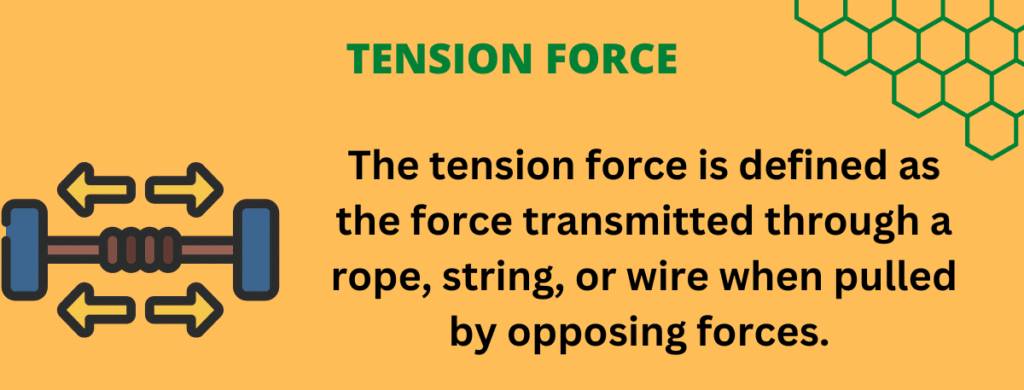The tension force is described as the force transferred through a rope, string, or wire when pulled by opposing forces. The tension force is directed along the length of the wire, pulling energy equally on the bodies at the ends.
Tension causes the material to lengthen or stretch. When a tension force is given to a very flexible object, such as a rubber band, it will stretch dramatically. Less flexible materials, such as plastic and steel, elongate when a pulling force is applied, but considerably less so.

Table of Contents
Tension Force Definition
Tension force is defined as the pulling force that acts along with a stretched flexible connector, such as a rope or cable. For instance, when a rope supports the weight of a stationary object, the tension in the rope equals the weight of the object: T = mg.
Tension Formula
T = mg ± ma
where:
- T indicates tension, N
- m denotes mass, kg
- g indicates gravitational force, 9.8 m/s2
- A denotes acceleration, m/s2
Different cases of tension force are listed below:
- Moving Upwards: T = W + ma
- Rocket Launch: When a rocket launches, it goes upwards while being pulled downwards by gravity (its weight, W). To overcome this force and continue ascending, the rocket must generate more force via its engines (ma). The tension (T) in the rocket’s wires or supports will equal the product of these two forces.
- Lifting a Crate: When you carry a crate off the ground, you are working against gravity (its weight, W). To lift it at a constant speed, you must apply an additional force equal to the crate’s mass (m) multiplied by the acceleration due to gravity (a). The tension (T) in the lifting mechanism will be equal to the crate’s weight plus this additional force.
- Moving Downwards: T = W – ma
- Lowering a Crate: When you lower a crate back to the earth, it slides downhill with the force of gravity (its weight, W) acting on it. To regulate its descent at a steady speed, you must provide a force in the opposite direction (upwards) equal to the weight of the crate minus the force of gravity acting on it (ma). The tension in the lowering mechanism (T) will be equal to this net force.
- Rappelling: When you rappel down a cliff, you are also sliding downwards under the influence of gravity. To control your fall, use your braking mechanism to apply an opposing force to the rope equal to your weight minus the force of gravity acting on you (ma). This net force will be equal to the tension in the rope (T).
- Suspended: T = W
- Hanging Chandelier: A chandelier hanging from a ceiling is suspended and not moving. The only force acting on it is its weight (W), which is balanced by the tension in the cables or chains supporting it (T). Therefore, T = W.
- Swing: When you swing on a swing, you are suspended in mid-air at the top of each swing. At this point, your weight (W) is balanced by the tension in the chains supporting the swing (T), so T = W.
- Moving at Uniform Speed: T = W
- Elevator: When you ride in a constant-speed elevator, you and the elevator experience the identical acceleration owing to gravity (g), hence there is no net force on you (ma = 0). As a result, the tension in the elevator cables or supports (T) must be equivalent to your weight (W).
- Ski Lift: When you ride on a ski lift moving at a constant speed, you are also experiencing no net force (ma = 0), so the tension in the lift cable (T) must be equal to your weight (W).

Summary of above cases is given in table below:
| Body Movement | Tension Formula | Example |
|---|---|---|
| Moving Upwards | T = W + ma | Rocket launch, lifting a crate |
| Moving Downwards | T = W – ma | Lowering a crate, rappelling |
| Suspended | T = W | Hanging chandelier, swing |
| Moving at Uniform Speed | T = W | Elevator, ski lift |
Daily Life Examples of Tension Force in Physics
In physics, tension refers to the force that is transmitted through a rope, cable, or any other object that is under tension. The tension force is a pulling force, and it acts along the length of the object.
Examples of the tension force in daily life include:
- A rope supporting a hanging object: When an object is suspended from a rope, the tension force in the rope equals the weight of the object, pulling down vertically.
- A person dragging a sled: The person puts a force on the sled, which is communicated as tension through the rope.
- When a guitar string is plucked, the tension in the string forms a sound wave that travels to the guitar body and produces sound.
- Tightrope walker: A tightrope walker utilizes a pole to maintain balance while walking on a tightrope. The tension in the tightrope provides the necessary support to protect the walker from falling.
In each of these examples, the tension force acts to transmit a force from one object to another and to maintain balance. It is an important concept in physics and is used in a variety of applications, including engineering, mechanics, and material science.
More Examples of Tension Force
Following are some additional tension force examples:
- The tension of the cables is employed for rock climbing or ascending tough terrain.
- Using pulleys, tension force in the rope can be employed to extract water from wells.
- Elevators make use of high-tension cables.
- Tension is created in the rope during a tug-of-war game.
- Helicopter cables use tension force to hoist people or large equipment during rescue missions.
- A rubber band is stretched
- an object subjected to tensile tension and strain
- Crane Machine for lifting and shifting items
- a vehicle towing another vehicle using a chain
ten. force exerted by suspension bridge cables# - Tent ropes secured to the ground
Solved Problem
1. A rope with a breaking strength of 3000 N is used to lift a load of 500 N. What is the tension force in the rope?
Solution:
The rope’s tension force equals the weight of the load plus any additional force required to overcome friction or other resistance factors. We’re assuming no friction or other resistive forces in this example, so the tension force is simply the weight of the load.
Tension force = Weight of the load = 500 N
Since the breaking strength of the rope is 3000 N, the tension force of 500 N is well below the rope’s maximum capacity and it is safe to use the rope for lifting this load.
More Links
- BCl3 Lewis Structure in four simple steps - November 1, 2023
- PH3 Lewis Structure in four simple steps - October 8, 2023
- PF3 Lewis structure in four simple steps - September 24, 2023



